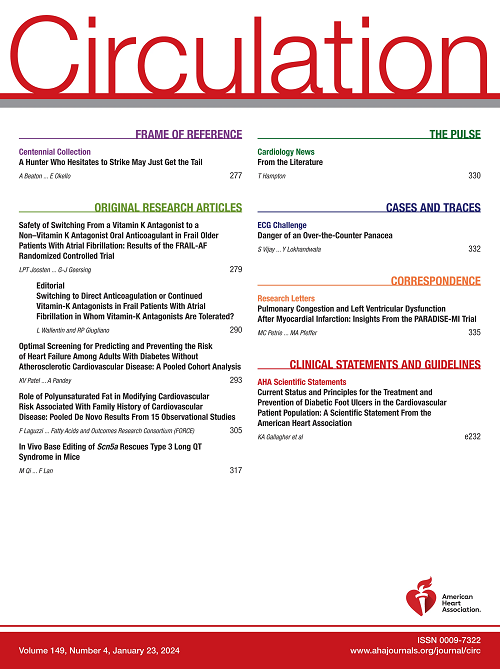Nonculprit Vulnerable Plaques and Prognosis in Myocardial Infarction With Versus Without ST-Segment Elevation: A PROSPECT II Substudy.
IF 38.6
1区 医学
Q1 CARDIAC & CARDIOVASCULAR SYSTEMS
引用次数: 0
Abstract
BACKGROUND Clinical guidelines recommend different revascularization strategies for nonculprit lesions in patients with ST-segment-elevation myocardial infarction (STEMI) versus non-STEMI (NSTEMI). Whether the prevalence of untreated high-risk vulnerable plaques differs in STEMI and NSTEMI and affects their outcomes is unknown. METHODS In PROSPECT II (Providing Regional Observations to Study Predictors of Events in the Coronary Tree II), a multicenter, prospective natural history study, patients with recent myocardial infarction underwent 3-vessel coronary angiography with coregistered near-infrared spectroscopy and intravascular ultrasound after successful percutaneous coronary intervention of obstructive lesions from 2014 through 2017. Two-feature high-risk plaques were defined as those with both plaque burden ≥70% and maximum lipid core burden index over any 4-mm segment ≥324.7. The primary end point was major adverse cardiovascular events arising from untreated nonculprit lesions during a median 3.7-year follow-up. RESULTS Of 898 patients, 199 (22.2%) with 849 nonculprit lesions had STEMI and 699 (77.8%) with 2784 nonculprit lesions had NSTEMI. By intravascular ultrasound, the median nonculprit lesion length was 17.4 mm (interquartile range, 16.3-18.5) in STEMI and 17.7 mm (interquartile range, 17.1-18.4) in NSTEMI (P=0.63), and the median minimal lumen area was 5.5 mm2 (interquartile range, 5.3-5.7 mm2) in STEMI and 5.5 mm2 (interquartile range, 5.3-5.6 mm2) in NSTEMI (P=0.99). At the lesion level, the prevalence of 2-feature high-risk nonobstructive nonculprit plaques was slightly higher in patients with STEMI than in patients with NSTEMI (12.8% versus 10.1%; P=0.03). At the patient level, however, the prevalence of 2-feature high-risk plaques was similar in STEMI versus NSTEMI (38.8% versus 32.7%; P=0.11). The prevalence of patients with 1 or more lesions meeting at least 1 high-risk plaque criterion was also similar (plaque burden ≥70%, 63.3% versus 57.8% [P=0.16]; maximum lipid core burden index over any 4-mm segment ≥324.7, 63.3% versus 57.6% [P=0.15]). The 4-year rates of nonculprit lesion-related major adverse cardiovascular events were similar in STEMI versus NSTEMI (8.6% versus 7.8%; hazard ratio, 1.02 [95% CI, 0.57-1.81]; P=0.95), as were the rates of all major adverse cardiovascular events (14.2% versus 13.0%; hazard ratio, 1.06 [95% CI, 0.68-1.64]; P=0.80). CONCLUSIONS In the PROSPECT II study, the per-patient prevalence of high-risk vulnerable plaques was comparable in STEMI versus NSTEMI, as was the overall long-term incidence of nonculprit lesion-related and all major adverse cardiovascular events. These results support a similar revascularization strategy for nonculprit lesions in patients with STEMI or NSTEMI after culprit lesion management. REGISTRATION URL: https://www.clinicaltrials.gov; Unique identifier: NCT02171065.非罪魁祸首易损斑块与st段抬高心肌梗死的预后:一项PROSPECT II亚研究。
临床指南推荐st段抬高型心肌梗死(STEMI)与非STEMI (NSTEMI)患者非元凶病变的不同血运重建策略。未治疗的高危易损斑块在STEMI和NSTEMI中是否存在差异并影响其预后尚不清楚。方法PROSPECT II(提供区域观察研究冠状动脉树事件预测因子II)是一项多中心前瞻性自然病史研究,2014年至2017年,近期心肌梗死患者在成功经皮冠状动脉介入治疗阻塞性病变后,接受了近红外光谱和血管内超声共登记的三支冠状动脉造影。双特征高危斑块定义为斑块负荷≥70%,任意4-mm段最大脂质核心负荷指数≥324.7。主要终点是在中位3.7年随访期间由未经治疗的非罪魁祸首病变引起的主要不良心血管事件。结果898例患者中,849例非罪魁祸首病变199例(22.2%)发生STEMI, 2784例非罪魁祸首病变699例(77.8%)发生NSTEMI。经血管内超声检查,STEMI非罪魁祸首病变长度中位数为17.4 mm(四分位数范围16.3 ~ 18.5),NSTEMI为17.7 mm(四分位数范围17.1 ~ 18.4)(P=0.63), STEMI最小管腔面积中位数为5.5 mm2(四分位数范围5.3 ~ 5.7 mm2), NSTEMI为5.5 mm2(四分位数范围5.3 ~ 5.6 mm2) (P=0.99)。在病变水平上,STEMI患者的2特征高风险非阻塞性非罪魁祸首斑块的患病率略高于非STEMI患者(12.8% vs 10.1%;P = 0.03)。然而,在患者水平上,STEMI和NSTEMI中2特征高危斑块的患病率相似(38.8%对32.7%;P = 0.11)。有1个或多个病变符合至少1个高危斑块标准的患者患病率也相似(斑块负担≥70%,63.3%对57.8% [P=0.16];最大脂质核心负荷指数≥324.7,分别为63.3%和57.6% [P=0.15])。非罪魁祸首病变相关的主要不良心血管事件的4年发生率在STEMI和NSTEMI中相似(8.6%对7.8%;风险比,1.02 [95% CI, 0.57-1.81];P=0.95),所有主要不良心血管事件的发生率也是如此(14.2% vs 13.0%;风险比,1.06 [95% CI, 0.68-1.64];P = 0.80)。在PROSPECT II研究中,STEMI和NSTEMI患者的每名高危易损斑块患病率相当,非罪魁祸首病变相关和所有主要不良心血管事件的总体长期发生率也相当。这些结果支持STEMI或非STEMI患者在罪魁祸首病变处理后的非罪魁祸首病变的类似血运重建策略。REGISTRATIONURL: https://www.clinicaltrials.gov;唯一标识符:NCT02171065。
本文章由计算机程序翻译,如有差异,请以英文原文为准。
求助全文
约1分钟内获得全文
求助全文
来源期刊

Circulation
医学-外周血管病
CiteScore
45.70
自引率
2.10%
发文量
1473
审稿时长
2 months
期刊介绍:
Circulation is a platform that publishes a diverse range of content related to cardiovascular health and disease. This includes original research manuscripts, review articles, and other contributions spanning observational studies, clinical trials, epidemiology, health services, outcomes studies, and advancements in basic and translational research. The journal serves as a vital resource for professionals and researchers in the field of cardiovascular health, providing a comprehensive platform for disseminating knowledge and fostering advancements in the understanding and management of cardiovascular issues.
 求助内容:
求助内容: 应助结果提醒方式:
应助结果提醒方式:


